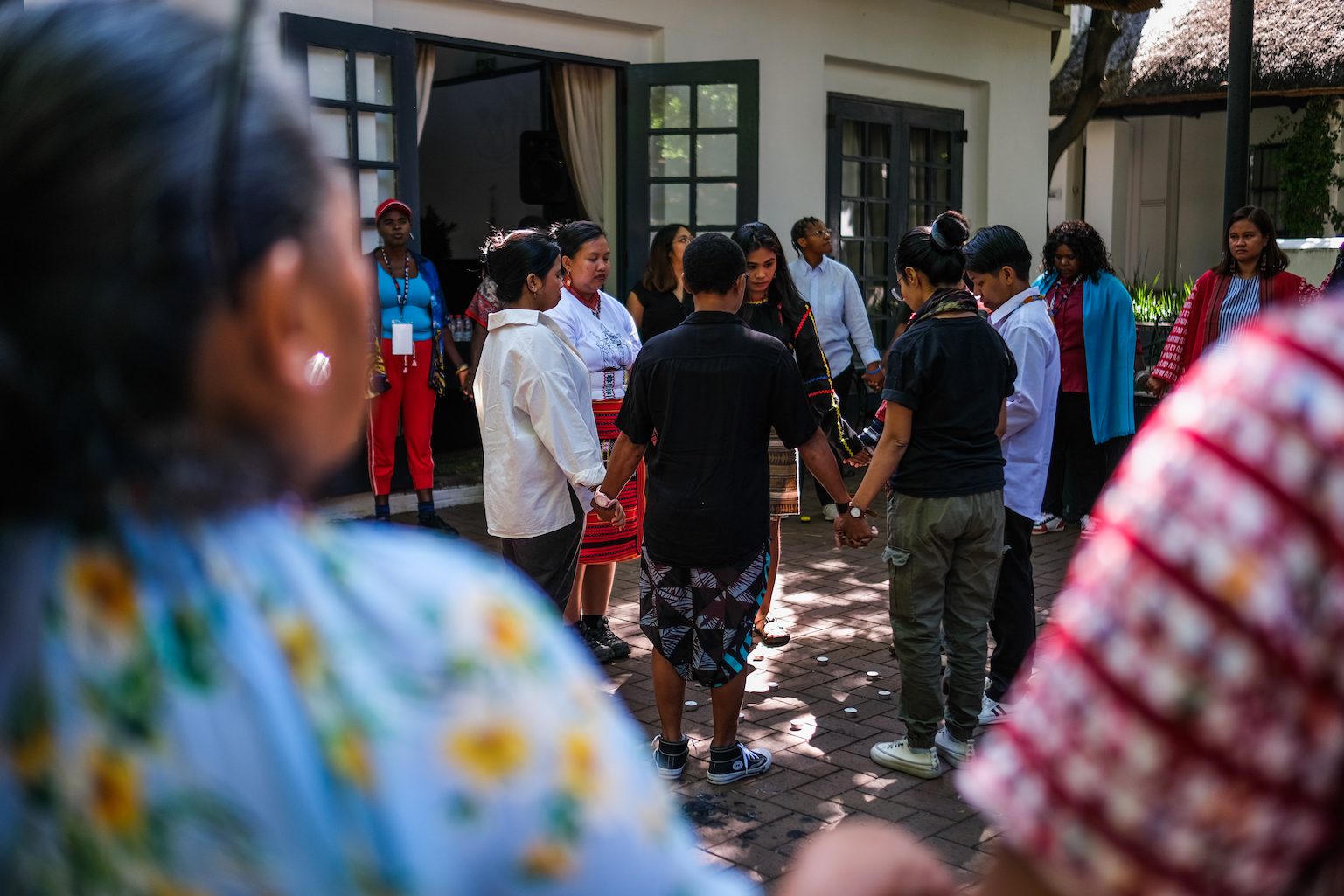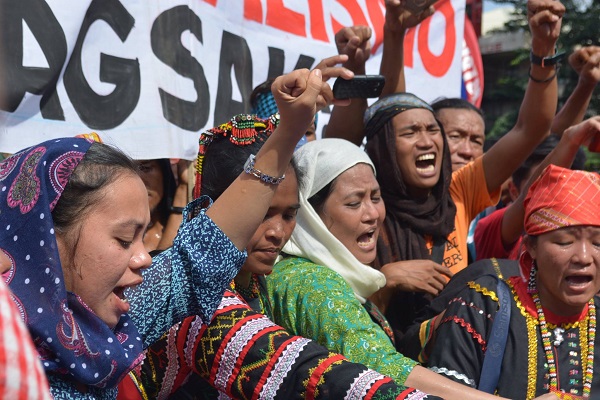



With President Donald Trump poised to pull the US out the 2015 Paris Climate Agreement, a hard-won global commitment to reduce carbon emissions, many fear the consequences for vulnerable communities and those already experiencing climate change related challenges. According to Global Witness, indigenous and rural women are not only some of the most impacted by climate change but also among the most targeted activists for defending their land, forests and rivers against unregulated destructive industries such as mining, logging and hydropower. In Southeast Asia, defending the environment (including land rights and water) is one of the most dangerous forms of activism. In the following blog, Mikas demonstrates why as she interviews activists from Thailand, the Philippines and Indonesia, who despite the risks they face, continue defend their territories, livelihoods, and rights.
Piya Macliing Malayao sat on the pavement, teary-eyed and bleeding. If she had her way, she would have been standing up to speak before the thousand tribal minorities and rights activists gathered in the streets. However, minutes before, a police van rammed into her and a dozen other protesters in an attempt to break up their peaceful demonstration.
The “Lakbayan” or “People’s Journey” organized the demonstration in Manila as part of the Philippine indigenous peoples march across the country to protest and assert their rights against the militarization and plunder of their ancestral lands.
Malayao is an Igorot, a member from a mountainous tribe in the northern Philippines. She is the Secretary General of Katribu, a national alliance of indigenous peoples’ organizations that brings forth the issues faced by tribal communities to the public’s attention both nationally and internationally.
She cannot forget the sound of the thud each time the police vehicle ran over a protestor. The van hit her legs. “I am angered by the brutality of the police. I could not walk for a few days because of the pain. I couldn’t function properly,” she said in Filipino.
Despite the harrowing experience, Malayao is firm in her resolve to demand her rights and the rights of her people. “These forms of violence wouldn’t end even if I stopped. On the contrary, it’s a victory for us if I continue,” she said.
The 27 year-old leader cited the example of the successful campaign of the Igorots to halt the construction of the Chico Dam on their lands. The dam was a top-priority project of the late dictator Ferdinand Marcos from the 70’s to the early 80’s. Construction of the dam would have inundated their ancestral lands. The indigenous peoples won an historic victory when they forced the government to stop the project in the 80s.
“Land is life to indigenous peoples, to lose land, is to lose their heritage,” Malayao explained. Unfortunately, protecting their resource-rich lands against mining and logging interests has been a constant struggle for tribal minorities in the Philippines.
In 2015, 700 Lumads, non-Muslim indigenous peoples in Mindanao, fled their homes and sought refuge at a church compound in Davao City after the Armed Forces of the Philippines moved into their communities with the pretext of fighting against guerrilla forces.
Soon after, the government charged the rights activists and church clergy who helped the Lumad families, with kidnapping, illegal detention and human trafficking. Among the accused was Cristina Palabay, a Manila-based rights monitor for Karapatan. “In the Philippine context, women human rights defenders are not only vilified as ‘terrorists’ or as ‘enemies of the state,’ we are also branded as ‘witches’ or ‘destroyers of families’ because while we uphold and fight for human and people’s rights, we also fight for the right to divorce; right to health, including reproductive health; and the non-sexist portrayal of women in media and in advertising,” Palabay said.
Where violent political conflict affects daily life in the Philippines , words are powerful. An adjective can elevate a woman’s social standing or condemn her to social censure. A noun can paint her either as a friend or an enemy — a critical distinction in conflict zones.
Women activists confront traditions that dictate the role women should play in the family and community. Philippine society largely maintains the outdated belief that a woman’s “proper” place is at home. “Women human rights defenders face twice the threats facing male human rights defenders, because of the double standards and the additional layer of oppression we face as women,” Palabay added.
Women defenders are frequently threatened by members of their own communities, and even their families, who see their work as a challenge to the traditional role of women.
Waewrin Buangern, called Jo, belongs to the organization Rak Ban Haeng, which means “We love Ban Haeng”. It’s a fitting name for a community organization that works to oppose a Lignite mining company in the village of Ban Haeng in the Ngao district of the Lampang province in northern Thailand. Lignite is a low-grade type of coal and the dirtiest of all fossil fuels.
Since 2010, the group has been speaking out against the operations of the mining company Green Yellow Co. Ltd. They fear the impact of the mining activities on the health and livelihoods of the people in the village.
Buangern was placed under surveillance by police and has faced intimidation and threats for defending her community’s land.
Representatives from the mining company paid a visit to the school, where she works as a teaching assistant for children with special needs. They pressured the school director until the director warned Buangern that her work is controversial and could tarnish the image of their institution.
When that didn’t stop Banguern, the company turned to bribes. Using her kin as mediators, the company offered her money and a new car to quit opposing the mining project.
Global Witness’ On Dangerous on Ground Report showed that the majority of the killings of 42 land and environmental defenders in 2015 were linked to the mining industry. The report noted that the actual death toll might be higher, since many of the killings occurred in remote villages or deep in rainforests, and thus may not have been reported as related to human rights activism.
In spite of the risks, Buangern never considered giving up. “Although victory is still far from sight, what I know is that we have not lost yet,” she said. Buangern fights to ensure a future where young people in her community can still enjoy land untainted by the anticipated environmental destruction of the mining operation. “We have started working with the young people in our community to make them aware and teach them that they should defend their home,” she said.
In Southeast Asia, cultural norms and practices of most traditional societies work to keep women from taking on the roles that Malalya palabar and Banguern have taken on.
Helda Khasmy, a human rights defender who leads the Riau chapter of Indonesian women’s organization Seruni, explains how they use organizing and alliance-building as powerful strategies to push back. Khasmy said her organization addresses the interconnected issues faced by women in the community. Seruni-Riau provides services to women and children victims of sexual abuse and tackles pressing community concerns, such as the thick haze from forest fires that is affecting the villagers. The slash-and-burn techniques used by firms to clear the woodlands surrounding forest cause the wild fires.
She said the two companies responsible for the haze in the province of Riau, Asia Pacific Resources International (April) and Sinar Mas, are protected by the military. “You cannot defeat these companies just by putting a poster out. They have guns, they have the government army supporting them,” she said.
To publicize their issues, Khasmy writes in the newspapers, talks on local television and at university forums, and organizes young women on campuses. “We achieved small victories from the government, like services for haze victims, after a lot of local and international pressure. We push for national and international solidarity. Sometimes we build alliances with the lower levels of government to fight at the national level. When we demonstrate, I call the governor to give him a message. We ensure that he signs the commitment in front of us.They (local government) come out because we have large constituencies,” she explained.
This same strategy helped Malayao and other defenders during the police crackdown in Manila in Oct. 2016. Health workers who joined in support of indigenous people’s rights were the first responders to those injured. Paralegals also helped free 25 people illegally arrested by police that day.
“We link the struggles and issues of indigenous peoples with other oppressed Filipinos as women, as workers, as peasants. We reach out to professionals, the church and academics. We are able to achieve greater victories through our collective struggle,” Khasmy added.
Even though her opponents view her as a troublemaker, Khasmy continues to speak out. “My problems cannot be solved by myself, but with all of the women in the local and national community. I want my children to lead good lives in the future, but I cannot fight for only my children. I must organize every woman so they can do what I can do.”